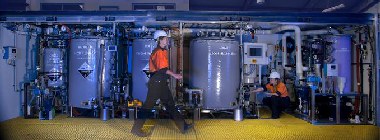A transportable plant that aims to demonstrate a process to recover uranium as a by-product from the phosphate fertiliser industry is about to start operations in the USA.
 |
| The portable PhosEnergy demonstration facility (Image: UEQ) |
The PhosEnergy process is being commercialised by Australian company Uranium Equities (UEQ) and Canadian uranium producer Cameco, under a strategic alliance agreement. Developed by 63% Cameco-27% UEQ-10% private equity partnership company Urtek in conjunction with the Australian Nuclear Science and Technical Organisation, the process recovers uranium as a by-product from wet process phosphoric acid, an intermediate product in the manufacture of phosphate fertiliser.
Industrial-scale uranium extraction from phosphate deposits is not in itself a new process: over the years some 20,000 tonnes of uranium has been produced as a phosphate by-product, particularly in the USA. By the mid-1990s the process had become uneconomic and all but ceased, but rising uranium prices and process refinements are changing the economic situation. The PhosEnergy process offers a refined ion exchange process with estimated operating costs of $25-30 per pound U3O8, around half the costs of the historical processes.
The process has already been demonstrated at the pilot plant scale, and a demonstration plant has been manufactured in Australia and shipped to the USA. The plant is contained inside two shipping containers to allow for easy mobilisation and transport. UEQ has now announced that it expects to complete commissioning the plant in May, with the plant operating for a demonstration period of 4-6 months. During this time, a series of campaigns will evaluate the process efficiency for feeds from various sources and information will be collected for the completion of a pre-feasibility engineering study.
According to UEQ managing director Bryn Jones, the commercialisation strategy for the process will initially focus on the US phosphate fertiliser industry where up to 6 million pounds U3O8 (2300 tU) could be recovered annually. The world's major phosphate-based fertiliser producers are located in northern Africa, North America and Asia, and according to UEQ up to 20 million pounds U3O8 (nearly 7700 tU) per year could be recovered as a byproduct from the industry. Cameco and UEQ are seeking to enter commercial arrangements with phosphate producers to provide the uranium recovery solution, plus the capital required to install the process, in exchange for an off-take of the output.
Researched and written
by World Nuclear News




_28178.jpg)
_66891.jpg)
_30199.jpg)
_72306.jpg)





